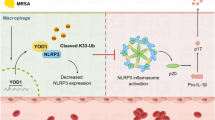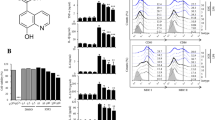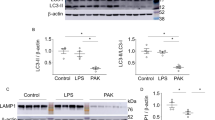Abstract
The ability to effectively clear infection is fundamental to host survival. Sepsis, defined as dysregulated host response to infection, is a heterogenous clinical syndrome that does not uniformly clear intact bacterial or sterile infection (i.e., lipopolysaccharide). These findings were further associated with increased survival in DJ-1 deficient animals exposed to intact bacteria relative to DJ-1 deficient challenged with lipopolysaccharide. We analyzed bacterial and lipopolysaccharide clearance in bone marrow macrophages (BMM) cultured ex vivo from wild-type and DJ-1 deficient mice. Importantly, we demonstrated that DJ-1 deficiency in BMM promotes Rubicon-dependent increase in L3C-associated phagocytosis, non-canonical autophagy pathway used for xenophagy, during bacterial but not lipopolysaccharide infection. In contrast to DJ-1 deficient BMM challenged with lipopolysaccharide, DJ-1 deficient BMM exposed to intact bacteria showed enhanced Rubicon complexing with Beclin-1 and UVRAG and consistently facilitated the assembly of complete autophagolysosomes that were decorated with LC3 molecules. Our data shows DJ-1 impairs or/and delays bacterial clearance and late autophagolysosome formation by binding to Rubicon resulting in Rubicon degradation, decreased L3C-associated phagocytosis, and decreased bacterial clearance in vitro and in vivo - implicating Rubicon and DJ-1 as critical regulators of bacterial clearance in experimental sepsis.
Similar content being viewed by others
Log in or create a free account to read this content
Gain free access to this article, as well as selected content from this journal and more on nature.com
or
Data availability
Data can be made available upon request.
References
Singer M, Deutschman CS, Seymour CW, Manu Shankar-Hari M, Annane D, Bauer M, et al. The third international consensus definitions for sepsis and septic shock (sepsis-3). JAMA. 2016;315:801–10.
Calvano SE, Xiao W, Richards DR, Felciano RM, Baker HV, Cho RJ, et al. A network-based analysis of systemic inflammation in humans. Nature. 2005;437:1032–7.
Binnie A, Walsh CJ, Hu P, Dwivedi DJ, Fox-Robichaud A, Patricia C, et al. Epigenetic profiling in severe sepsis: A pilot study of DNA methylation profiles in critical illness. Crit Care Med. 2020;48:142–50.
Lee WL, Slutsky AS. Sepsis and endothelial permeability. N. Engl J Med. 2010;363:689–91.
Cheng SH, Scicluna BP, Arts RJW, Gresnigt MS, Lachmandas E, Giamarellos-Bourboulis EJ, et al. Broad defects in the energy metabolism of leukocytes underlie immunoparalysis in sepsis. Nat Immunol. 2016;17:406–13.
Dos Santos CC. The role of the inflammasome in ventilator-induced lung injury. Am J Respir Crit Care Med. 2012;185:1141–4.
Cinel I, Dellinger RP. Advances in pathogenesis and management of sepsis. Curr Opin Infect Dis. 2007;20:345–52.
Nduka OO, Parrillo JE. The pathophysiology of septic shock. Crit Care Clin. 2009;25:677–702.
Nathan C. Points of control in inflammation. Nature. 2002;420:846–52.
Masud S, Prajsnar TK, Torraca V, Lamers GEM, Benning M, Van Der Vaart M, et al. Macrophages target Salmonella by Lc3-associated phagocytosis in a systemic infection model. Autophagy. 2019;15:796–812.
Martinez J, Malireddi RKS, Lu Q, Cunha LD, Pelletier S, Gingras S, et al. Molecular characterization of LC3-associated phagocytosis reveals distinct roles for Rubicon, NOX2 and autophagy proteins. Nat Cell Biol. 2015;17:893–906.
Nunes P, Demaurex N, Dinauer MC. Regulation of the NADPH oxidase and associated ion fluxes during phagocytosis. Traffic. 2013;14:1118–31.
Akoumianaki T, Vaporidi K, Diamantaki E, Pène EF, Beau R, Gresnigt MS, et al. Uncoupling of IL-6 signaling and LC3-associated phagocytosis drives immune paralysis during sepsis. Cell Host Microbe. 2021;29:1277–93.
Amatullah H, Shan Y, Beauchamp BL, Gali PL, Gupta S, Maron-Gutierrez T, et al. DJ-1/PARK7 Impairs bacterial clearance in sepsis. Am J Respir Crit Care Med. 2017;195:889–905.
Amatullah H, Maron-Gutierrez T, Shan Y, Gupta S, Tsoporis JN, Varkouhi AK, et al. Protective function of DJ-1/PARK7 in lipopolysaccharide and ventilator-induced acute lung injury. Redox Biol. 2021;38:101796.
Ren H, Fu K, Mu C, Li B, Wang D, Wang G. DJ-1, a cancer and Parkinson’s disease associated protein, regulates autophagy through JNK pathway in cancer cells. Cancer Lett. 2010;297:101–8.
Oh SE, Mouradian MM. Regulation of signal transduction by DJ-1. Adv. Exp. Med. Biol. 2017;1037:97–131.
Liang C. Negative regulation of autophagy. Cell Death Differ. 2010;17:1807–15.
Zhang XJ, Chen S, Huang KX, Le WD. Why should autophagic flux be assessed? Acta Pharmacologica Sin. 2013;34:595–9.
Yang C-S, Rodgers M, Min C-K, Lee J-S, Kingeter L, Lee J-Y, et al. The autophagy regulator rubicon is a feedback inhibitor of CARD9-mediated host innate immunity. Cell Host Microbe. 2012;11:277–89.
Russell JA, Walley KR, Singer J, Gordon AC, Hébert PC, Cooper DJ, et al. Vasopressin versus norepinephrine infusion in patients with septic shock from the iCAPTURE centre. N. Engl J Med. 2008;358:877–87.
Dichgans M, Malik R, König IR, Rosand J, Clarke R, Gretarsdottir S, et al. Shared genetic susceptibility to ischemic stroke and coronary artery disease: A genome-wide analysis of common variants. Stroke. 2014;45:24–36.
Matsunaga K, Saitoh T, Tabata K, Omori H, Satoh T, Kurotori N, et al. Two Beclin 1-binding proteins, Atg14L and Rubicon, reciprocally regulate autophagy at different stages. Nat Cell Biol. 2009;11:385–96.
Yorimitsu T, Klionsky DJ. Autophagy: molecular machinery for self-eating. Cell Death Differ. 2005;12:1542–52. Suppl 2.
Gupta S, Lee C-M, Wang J-F, Parodo J, Jia S-H, Hu J. Heat-shock protein-90 prolongs septic neutrophil survival by protecting c-Src kinase and caspase-8 from proteasomal degradation. J Leukoc Biol. 2018;103:933–44.
Jia S-H, Parodo J, Kapus A, Rotstein OD, Marshall JC. Dynamic regulation of neutrophil survival through tyrosine phosphorylation or dephosphorylation of caspase-8. J Biol Chem. 2008;283:5402–13.
Gupta S, Tsoporis JN, Jia S-H, Dos Santos CC, Parker TG, Marshall JC. Toll-like receptors, associated biochemical signaling networks, and S100 ligands. Shock. 2021;56:167–77.
Watson R, Redmond H, Wang J, Condron C, Bouchier-Hayes D. Neutrophils undergo apoptosis following ingestion of Escherichia coli. J Immunol. 1996;156:3986–92.
Walley KR, Thain KR, Russell JA, Reilly MP, Meyer NJ, Ferguson JF, et al. PCSK9 is a critical regulator of the innate immune response and septic shock outcome. Sci Transl Med. 2014;6:258ra143.
Acknowledgements
We thank Dr. David Park from the University of Ottawa for providing the control and DJ-1 adenovirus vectors. Secondly, we thank Drs. Caterina Di Ciano-Oliveira and Yuexin Shan from St. Michael’s Hospital (Unity Health) for their support and technical assistance with the experiments. This work was supported by the Canadian Institutes of Health Research (Grant # MOP-130331 to CCDS) and the Ontario Research Fund (Grant # RE07-086 to CCDS).
Author information
Authors and Affiliations
Contributions
SG, HA, GDF, and CCDS designed the experiments; SG, HA, KW, APTM, AME, AKV, CMV, AF, AF, SNB, CF, JAR, and KRW performed the experiments; SG, HA, JNT, and CCDS analyzed the data. AA, TGP, JCM, PRMC, GDF, TMW, and CCDS contributed material. SG, HA, JNT, and CCDS wrote the manuscript.
Corresponding author
Ethics declarations
Competing interests
The authors declare no competing interests.
Ethics approval
All protocols using animals were approved by the St. Michael’s Hospital Animal Care Committee at Unity Health Toronto. For the human study, a clinical trial was conducted between July 2001 and April 2006 in 27 centers in Canada, Australia, and the United States and was approved by the research ethics boards of all participating institutions.
Additional information
Publisher’s note Springer Nature remains neutral with regard to jurisdictional claims in published maps and institutional affiliations.
Edited by E Baehrecke
Rights and permissions
About this article
Cite this article
Gupta, S., Amatullah, H., Tsoporis, J.N. et al. DJ-1 binds to Rubicon to Impair LC-3 Associated Phagocytosis. Cell Death Differ 29, 2024–2033 (2022). https://doi.org/10.1038/s41418-022-00993-2
Received:
Revised:
Accepted:
Published:
Issue date:
DOI: https://doi.org/10.1038/s41418-022-00993-2
This article is cited by
-
Macrophage polarization and metabolism in atherosclerosis
Cell Death & Disease (2023)



